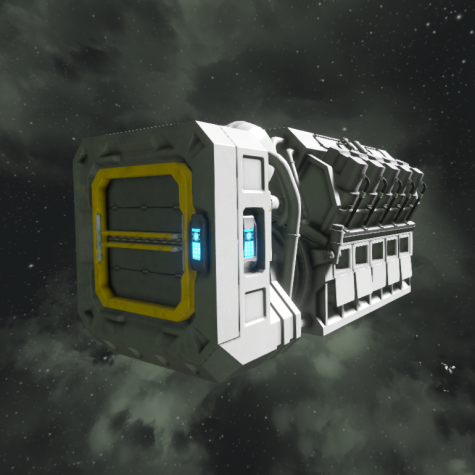Hydrogen Engine


Power block information is listed in the table down below.
| Components | Required |
| Steel Plate | 20 |
| Construction Component | 10 |
| Functional | |
| Power Cell | 1 |
| Computer | 4 |
| Hack | |
| Motor | 12 |
| Small Steel Tube | 20 |
| Large Steel Tube | 12 |
| Construction Component | 60 |
| Steel Plate | 80 |
| Info | |
| Dimensions (W,H,L) | 1,1,2 |
| Mass | 3,253.8 kg |
| Integrity | 13,654 |
| Build Time | 60 s |
| Fuel Capacity | 100,000 L |
| Fuel Efficiency | 2.778 Wh/L |
| Max Power Output | 5 MW |
| Power Consumer Group | Generators |
| Is Airtight | No |
| PCU Cost | 25 |
| Components | Required |
| Steel Plate | 10 |
| Construction Component | 2 |
| Functional | |
| Power Cell | 1 |
| Computer | 1 |
| Hack | |
| Motor | 4 |
| Small Steel Tube | 6 |
| Large Steel Tube | 4 |
| Construction Component | 18 |
| Steel Plate | 20 |
| Info | |
| Dimensions (W,H,L) | 3,2,2 |
| Mass | 1,005.2 kg |
| Integrity | 4,141 |
| Build Time | 40 s |
| Fuel Capacity | 5,000 L |
| Fuel Efficiency | 2.778 Wh/L |
| Max Power Output | 0.5 MW |
| Power Consumer Group | Generators |
| Is Airtight | No |
| PCU Cost | 25 |
Overview
The Hydrogen Engine is a block used to generate power by consuming Hydrogen.
At its peak capacity of 5 MW, the large engine consumes 500 liters of hydrogen per second while the small-grid version consumes 50 L/s at 0.5 MW.
| Tank | Capacity | Large Engine 5 MW (500 L/s) |
Small Engine 0.5 MW (50 L/s) |
|---|---|---|---|
| 15,000,000 L | 8 hours, 20 minutes and 0 seconds | 3 days, 11 hours, 20 minutes and 0 seconds | |
| 1,000,000 L | 33 minutes and 20 seconds | 5 hours, 33 minutes and 20 seconds | |
| 100,000 L | 3 minutes and 20 seconds | – | |
| 500,000 L | 16 minutes and 40 seconds | 2 hours, 46 minutes and 40 seconds | |
| 15,000 L | 30 seconds | 5 minutes and 0 seconds | |
| 5,000 L | – | 1 minute and 40 seconds |
Usage
Connect to a conveyor system that has Hydrogen Tanks (with Hydrogen gas) or O2/H2 Generators to refuel.
Because the engine uses the conveyor system to fill itself with hydrogen, a minimal level of power is required for the engine to start if it is empty. The internal tank of the engine is only refilled while the engine is actively running, and its contents cannot be siphoned by other blocks.
The engine prioritizes the recharging of batteries over filling other power demands, incurring the 20% energy loss as the batteries immediately use that energy to run any other powered blocks.
Indicator
Only the large-grid version has any indicator lights: Recessed into the electrical box next to its control panel, above the cylinder heads in the center, and at the corners of the front fan. Green is functional, yellow when out of hydrogen, and red when turned off.
Efficiency
The large Hydrogen Engine consumes 0.36 liters of hydrogen for every watt-hour it produces, while the large O2/H2 Generator can produce up to 3.6 liters of hydrogen for every watt-hour it consumes. This gives the Hydrogen Engine efficiency of 90%. In other words, if you have a closed circuit of Hydrogen Engines and O2/H2 Generators, you will spend 1 out of every 10 liters of hydrogen on power generation.
